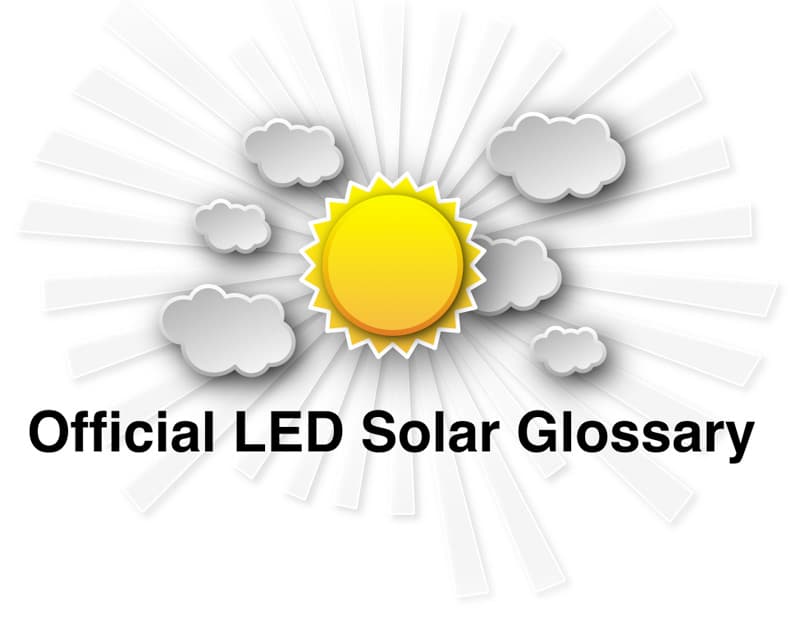


AIC • Alternative Energy • Beam Angle • CRI • Crystalline Silicon • Electrical Grid • Federal Tax Credit • Full Sun • Incident Light • Inverter • IP Rating • Kelvin • LiFeP04 • Li-ion • Lumens • Amp • Monocrystalline Silicon Cell • Ni-CD Battery • Peak Sun Hours • Photoelectric Cell • Photovoltaic • PIR • Rated Battery Capacity • Renewable Energy • Solar Batteries • Solar Cell • Solar Energy • Solar Panel • Solar Panel Efficiency • Watt
AIC • Alternative Energy • Beam Angle • CRI • Crystalline Silicon • Electrical Grid • Federal Tax Credit • Full Sun • Incident Light • Inverter • IP Rating • Kelvin • LiFeP04 • Li-ion • Lumens • Amp • Monocrystalline Silicon Cell • Ni-CD Battery • Peak Sun Hours • Photoelectric Cell • Photovoltaic • PIR • Rated Battery Capacity • Renewable Energy • Solar Batteries • Solar Cell • Solar Energy • Solar Panel • Solar Panel Efficiency • Watt


► Our 30 Day Product Return Policy
► Our 30 Day Product Return Policy
Need To Return A Product ?
Our products are very high quality. We strive to insure that our customers are completely satisfied with their purchase. If you are not satisfied with your product, you may request to return the merchandise for a refund within 30 days of the original invoice date.
If your return qualifies, we will issue an RMA number and provide you with an address and return instructions. *We must receive the product within 14 days of our RMA issuance-authorization.
*You may return your purchase within 30 days of invoice date, subject to the following:
1. All returns must be approved by LED Solar Supply. The "Return Merchandise Authorization" (RMA) number you are issued must be clearly marked on the outside of your return shipment package. Returns received without RMA Authorization will be rejected. We are not responsible for product returned without an RMA number.
2. All returns and exchanges must include a copy of the invoice or order number.
3. Return product within the 30 day time period must not show damage, writing or markings on product or its box, excessive use or modified in any way.
4. Products must be in their original cartons and boxes, and shipped with sufficient packaging material to ensure that they are resalable.
5. All ancillary items must also be returned and be in salable condition.
6. Return shipping is the responsibility of the customer.
7. Credit card processing fees may not be refundable.
8. Special orders, custom kelvin temperatures and custom beam angle products are sold as a final sale. These products are non-returnable and non-refundable under any circumstances. No exceptions.
9. Product returned after 30 days, may be subject to a restocking fee of 20%.
10. Cost of the shipping will be withheld from the refund for products without manufacturer's defect.
11. For Replacement RMA, LED Solar Supply reserves the right to substitute comparable brands and styles, and repair or refurbish warranty products if necessary, to satisfy the warranty exchange, based on stock on hand.
12. No product will be accepted for return, exchange or credit if there is writing on the product or its packaged box. No exceptions.
CANCELLATIONS:
If you would like to cancel a solar lighting order and we are able to do so before it ships, there will be no additional cost. If your order has shipped, it cannot be cancelled and is subject to the return policy.
WARRANTY:
All LED Solar Supply products are warranted against defective parts, labor and materials.
Warranty does not cover incorrect installation, misuse, abuse, acts of god or animal-insect infestation. No product will be accepted under warranty if there is writing on product or product packaging. Product returned showing any visible damage will void warranty and not be accepted for replacement or refund. No Exceptions.
If your product fails within the warranty period:
Call our Toll Free number at (800) 928-4558
Or use our online RMA Request Form Here.
Customer service will review your request, will issue an RMA number for return of product for credit or replacement. Once approved RMA product is received and verified as ours: Replacement products ship at no freight cost to the customer. Advanced RMA replacements require Credit Card on file.
ORDERS:
LED Lighting orders can be placed online or by calling us Toll Free at: (800) 928-4558. Phone orders can be placed from 8 am to 5pm (PST) Monday through Friday.
For larger orders, we encourage you to call for assistance to insure your order is correct.
Feel free to order online anytime.
CUSTOM LED LIGHTING:
LED Solar Supply can offer special orders, such as custom kelvins and beam angles. Extra lead times may apply.
SUPPORT SERVICES:
If you have questions about your order, email them by using the Connect With Us form at the bottom of this page.
Inquiries are answered by our Sales or Technical Department within 24 hours. You can also contact us by using our Online Live Chat or our Toll Free Telephone number.
SHIPPING:
We Do Not Ship To P.O. Boxes.
Since we are an Internet based LED sales company, our inventory is dynamic and subject to change at any time. Larger quantities may require additional lead time for shipping. Orders will ship UPS or FED EX Ground. Expedited shipping is available upon request. *Expedited shipping must be requested by phone to confirm additional costs. Special rates would apply.
RETURN & SHIPPING REQUIREMENTS:
1. Returns must have the RMA number on the outside of the return shipment package.
2. Returns received without an RMA number will be returned/refused.
3. Do not write on products or product boxes.
RETURN PRODUCTS TO:
LED SOLAR SUPPLY
2248 TOWNSGATE ROAD, UNIT #4
WESTLAKE VILLAGE CA 91361
▶︎ LED Solar Supply
📞 (800) 928-4558